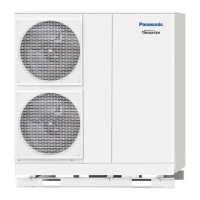190 Aquarea air-to-water heat pumps - Planning and installation manual - 02/2022
Installation
6
4. Close the valve on the low pressure side of the manometer station and switch o the vacuum
pump.
5. Recheck whether the measured value remains constant at -1 bar for 10 minutes.
Yes: In this case you can assume that the refrigerant circuit is tight and go directly to step 7.
No: In this case, there is presumably still a leakage in the refrigerant circuit. Remove the
leakage by performing step 6.
6. If the manometer display does not remain constant at -1 bar, rst tighten the connections.
Then evacuate the system again as described above. If the measured value of -1 bar is still
not maintained, search and repair the leaking places and then again perform step 5, until the
refrigerant circuit is denitely tight.
7. If the manometer display shows -1 bar for 10 minutes, loosen the hose from the vacuum
pump and the service port of the 3-way valve.
8. Tighten the valve cap on the service port of the 3-way valve by means of a torque wrench
with a torque of 18 Nm.
9. Remove the valve caps on the valve spindles of the 2-way and 3-way valves.
10. Open both the valves completely by using a hexagonal spanner (SW 4) so that the
refrigerant streams into the system. Check that the refrigerant quantity is sucient, otherwise
top up with the required refrigerant quantity (→ 4.6.2.3 Technical Data (bi-bloc systems),
p. 40, → 4.6.3.3 Technical Data (mono-bloc systems), p. 55).
11. Screw the valve caps back onto the valve spindles of the 2-way and 3-way valves.
12. Examine the connections for leakage.
Schematic representation of system evacuation
Lo
Hi
1
2
3
4
5
6
78
9
10
1 Hydrokit
2 Refrigerant liquid pipe
3 2-way valve, closed
4 Outdoor unit
5 3-way valve, closed
6 Refrigerant discharge pipe
7 Manometer low-pressure side: CLOSED
8 Manometer high-pressure side: OPEN
9 Adapter of the vacuum pump
10 Vacuum pump

